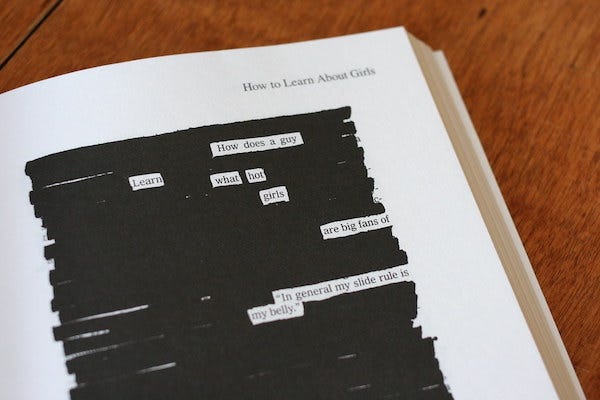Revealing Poetry: The Art of Erasure
Michel de Certeau wrote in his book The Practice of Everyday Life, "Books are only metaphors of the body." The move to digital texts, which is gaining more and more zeal by the day, has put the not only the fetishization of books as objects in jeopardy but also seemingly the want or need for them at all. As Jonathan Safran Foer (see below) puts it, “When a book remembers, we remember. It reminds you that you have a body. So many of the things we may think of as burdensome are actually the things that make us more human.”
Erasure poetry both deconstructs and demonstrates the idea that books are bodies, playing operation with structure, doing surgery on syntax. My dear friend Danika Stegeman LeMay has a full book-length erasure of the text from God is in the Small Stuff for the Graduate by Bruce Bickel and Stan Jantz (Barbour Publications, 2004). It's called called GOD IS IN THE MALL, and an excerpt is available in Vol. 30 of Word for/ Word. This page gets right to it:
Danika's is the latest example of this practice I've seen done well, but the first was a while ago. Maybe it’s apt that I don’t remember exactly how or where, but I came across Tom Phillips‘ “treated Victorian novel,” A Humument (Tetrad Press, 1970), two decades ago at San Diego State University. Phillips took William Mallock’s A Human Document (Cassell Publishing, 1892) and obscured words on every page, leaving a few here and there to tell a new story. It’s part painting, part drawing, part collage, part poetic cut-up, and all weirdly, intriguingly unique.
Phillips claims that he picked A Human Document because of its price-point (“no more than three pence,” he said), but Mallock’s “novel” is oddly suited for Phillips’ repurposing. The original novel is a scrapbook of sorts of journal entries, correspondence, and other ephemera left behind by two deceased lovers. Mallock wrote of these scraps in his introduction that “as they stand they are not a story in any literary sense; though they enable us, or rather force us, to construct one out of them for ourselves.” In her book Writing Machines, N. Katherine Hayles characterizes this introduction as “uncannily anticipating contemporary descriptions of hypertext narrative.”
In a simpler example, Austin Kleon “stole like an artist” and created a best-seller using only markers and copies of The New York Times. His Newspaper Blackout (Harper Perennial, 2010) takes Tom Phillips’ methodology to its most basic tenet: poetry as erasure.
Taking a step up instead of down, Jonathan Safran Foer opted for physical subtraction, creating a textual sculpture. Foer treated his favorite novel, The Street of Crocodiles by Bruno Schulz (Penguin, 1963), by cutting out words, creating Tree of Codes (Visual Editions, 2010). You can watch the making-of on YouTube.
Giving due credit to his forebears, Foer told The New York Times, “It was hardly an original idea: it’s a technique that has, in different ways, been practiced for as long as there has been writing — perhaps most brilliantly by Tom Phillips in his magnum opus, A Humument. But I was more interested in subtracting than adding, and also in creating a book with a three-dimensional life. On the brink of the end of paper, I was attracted to the idea of a book that can’t forget it has a body.” Foer also acknowledges the project’s constraints as well as the power of his source material, adding,
Working on this book was extraordinarily difficult. Unlike novel writing, which is the quintessence of freedom, here I had my hands tightly bound. Of course 100 people would have come up with 100 different books using this same process of carving, but every choice I made was dependent on a choice Schulz had made. On top of which, so many of Schulz’s sentences feel elemental, unbreakdownable. And his writing is so unbelievably good, so much better than anything that could conceivably be done with it, that my first instinct was always to leave it alone.
For about a year I also had a printed manuscript of The Street of Crocodiles with me, along with a highlighter and a red pen. The story of Tree of Codes is continuous across pages, but I approached the project one page at a time: looking for promising words or phrases (they’re all promising), trying to involve and connect what had become my characters. My first several drafts read more like concrete poetry, and I hated them.
As opposed to the anyone-can-do-it tack of Kleon, Foer took the tools and text at hand and made something truly new. Like A Humument before it, Tree of Codes is a unique object worthy of thoughtful consideration. As DJ Scratch once said, “The reason we respect something as an art is because it’s hard as fuck to do.” Taking elements of others’ work and making it your own is one thing. Taking the whole damn thing and completely transforming it into something else is art.
15th ANNIVERSARY OF FOLLOW FOR NOW:
Today is the last day to take advantage of my 15th anniversary celebration offer! If you send me your receipt for the purchase of a paperback copy of Follow for Now, Vol. 2 from punctum books, I'll send you a signed copy of Vol. 1! Get all 80 interviews! Two decades of thought from minds of all kinds! If you're still not convinced, here's more about Vol. 2!
ICYMI:
Also, in case you missed them in all of that, I have three (3!) new books out:
Follow for Now, Vol. 2: More Interviews with Friends and Heroes (from punctum books)
Fender the Fall (a sci-fi novella from Alien Buddha Press)
Abandoned Accounts (poetry collection from First Cut)
As always, thank you for your continued interest and support! It is appreciated.
Hope you're well,
-royc.
http://roychristopher.com









